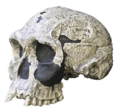"LB1". Homo floresiensis is thought to have arrived on Flores around 1.27–1 million years ago. There is debate as to whether H. floresiensis represents...
73 KB (7,615 words) - 07:40, 17 January 2025
size. Much like H. floresiensis, H. luzonensis presents a number of characteristics more similar to Australopithecus and early Homo than to modern humans...
15 KB (1,683 words) - 19:37, 26 December 2024
H. floresiensis was placed with Australopithecus sediba, H. habilis and Dmanisi Man, raising the possibility that the ancestors of H. floresiensis left...
94 KB (8,018 words) - 00:26, 21 January 2025
Human evolution (redirect from Evolution of Homo sapiens)
an ongoing debate over whether H. floresiensis is indeed a separate species. Some scientists hold that H. floresiensis was a modern H. sapiens with pathological...
264 KB (26,357 words) - 15:09, 20 January 2025
ebu gogo folklore has gained public attention with the discovery of Homo floresiensis, an extinct hominid species that inhabited Flores until c. 50,000...
7 KB (739 words) - 20:43, 12 August 2024
Homo floresiensis is currently thought to be Homo habilis, but this is subject to change with new information. Tooth wear from Homo floresiensis implies...
38 KB (5,040 words) - 04:29, 7 January 2025
Neanderthal (redirect from Homo sapiens neanderthalensis)
humans in Europe Homo floresiensis – Extinct small human species found in Flores Homo luzonensis – Archaic human from Luzon, Philippines Homo naledi – South...
336 KB (36,504 words) - 23:28, 18 January 2025
boisei Homo – immediate ancestors of modern humans Homo gautengensis† (probable H. habilis specimens) Homo rudolfensis† Homo habilis† Homo floresiensis† Homo...
30 KB (2,975 words) - 11:50, 27 December 2024
Human taxonomy (redirect from Homo sapiens sapiens)
descendant species such as Homo ergaster, Homo floresiensis, Homo antecessor, Homo heidelbergensis and indeed Homo sapiens is not entirely clear. The type fossil...
35 KB (5,154 words) - 08:40, 14 January 2025
region is of some importance in paleoanthropology, e.g. Homo erectus in Java, Homo floresiensis in Flores, and until the early anatomically modern human...
27 KB (3,531 words) - 08:48, 19 December 2024
Teuku Jacob (section Homo floresiensis)
remains discovered in Flores belonged to a new species in the genus Homo, Homo floresiensis. Jacob studied at Gadjah Mada University's School of Medicine from...
7 KB (590 words) - 03:56, 27 September 2024
been known from such a recent date in Africa. The smaller-brained Homo floresiensis of Indonesia lived on an isolated island and, apparently, became extinct...
56 KB (6,280 words) - 19:50, 17 January 2025
Brain size (section H. floresiensis' small brain)
division of labor and sharing of information as possible causes. Homo floresiensis is a hominin from the island of Flores in Indonesia with fossils dating...
54 KB (6,276 words) - 14:31, 13 January 2025
Laron syndrome (section Homo floresiensis)
Arabia, Japan, and China. Recent publications have proposed that Homo floresiensis represented a population with widespread Laron syndrome, based upon...
28 KB (2,885 words) - 18:38, 17 November 2024
holotype specimen of Homo floresiensis, also known as the "hobbit." Despite the small stature and brain size, Homo floresiensis was capable of using stone...
17 KB (2,000 words) - 23:44, 24 December 2024
John McWhorter (section The matter of Austronesian languages without affixes, and Homo Floresiensis)
simplification by acquisition during adulthood. He links this with Homo floresiensis, the most recent individuals known dated from 12,000 years ago. Austronesians...
35 KB (3,424 words) - 18:15, 10 December 2024
Prehistoric Indonesia (section Homo floresiensis)
descended from Homo Erectus and reduced in size over thousands of years by a well known process called island dwarfism. Homo floresiensis was first dated...
36 KB (4,133 words) - 06:38, 10 January 2025
Dean Falk (section Homo floresiensis)
emergence of language. She and colleagues described the brain of Homo floresiensis ("Hobbit") in 2005. In 2013, Falk and colleagues described the cerebral...
13 KB (1,701 words) - 04:45, 14 December 2024
and had been involved in the discovery of fossilised remains of Homo floresiensis, which he nicknamed "The Hobbit" at a Queensland university. The Heelers...
24 KB (1,791 words) - 19:50, 19 January 2025
shows that Homo floresiensis likely became extinct 50,000 years ago, around the time of modern human arrival to the archipelago. H. floresiensis skull, Cantonal...
62 KB (6,718 words) - 21:38, 9 December 2024
joins a larger body of East Asian Homo species which have been erected in the 21st century: the insular H. floresiensis and H. luzonensis, and the Chinese...
6 KB (616 words) - 18:32, 8 January 2025
Denisovan (redirect from Homo Denisovan)
west), the second known human species to do so, along with earlier Homo floresiensis. By this logic, they may have also entered the Philippines, living...
73 KB (7,485 words) - 08:07, 11 January 2025
Timeline of human evolution (section Homo)
Richard G. (30 March 2016). "Revised stratigraphy and chronology for Homo floresiensis at Liang Bua in Indonesia". Nature. 532 (7599): 366–69. Bibcode:2016Natur...
88 KB (3,505 words) - 06:40, 7 January 2025
Homo habilis (lit. 'handy man') is an extinct species of archaic human from the Early Pleistocene of East and South Africa about 2.4 million years ago...
52 KB (6,319 words) - 17:55, 12 January 2025
Mata Menge (section Comparison to H. floresiensis)
smaller than those of Homo floresiensis. The size and shape of the teeth of the Mata Menge fossils are similar to those of H. floresiensis, but the Mata Menge...
15 KB (1,436 words) - 07:34, 21 May 2024
denisova Homo sapiens Homo floresiensis Homo luzonensis Cast of a skull of Sahelanthropus tchadensis, nick-named ″Toumaï″ Skull of Homo rudolfensis Evolutionary...
24 KB (2,425 words) - 09:39, 19 December 2024
Paleolithic (section Homo erectus)
erectus to reach the island of Flores and evolve into the small hominin Homo floresiensis. However, this hypothesis is disputed within the anthropological community...
107 KB (11,395 words) - 23:02, 12 January 2025
Human (redirect from HomoSapiens)
Humans (Homo sapiens) or modern humans are the most common and widespread species of primate, and the last surviving species of the genus Homo. They are...
262 KB (25,179 words) - 11:18, 19 January 2025
an equally sized continental ancestor. Similarly, the early human, Homo floresiensis, had a brain of similar size to that of the significantly earlier...
30 KB (3,172 words) - 17:59, 11 January 2025
discovery of Homo floresiensis in the nearby Liang Bua cave in 2003. The Rampasasa have since been reported as claiming Homo floresiensis as their ancestor...
3 KB (253 words) - 09:59, 7 August 2024























